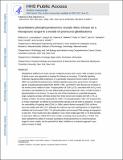Quantitative Phosphoproteomics Reveals Wee1 Kinase as a Therapeutic Target in a Model of Proneural Glioblastoma
Author(s)
Lei, Liang; Bakken, Katrina K.; Sims, Peter A.; Sarkaria, Jann N.; Canoll, Peter; Lescarbeau, Rebecca S.; White, Forest M.; ... Show more Show less
Downloadnihms778441.pdf (2.544Mb)
OPEN_ACCESS_POLICY
Open Access Policy
Creative Commons Attribution-Noncommercial-Share Alike
Terms of use
Metadata
Show full item recordAbstract
Glioblastoma (GBM) is the most common malignant primary brain cancer. With a median survival of about a year, new approaches to treating this disease are necessary. To identify signaling molecules regulating GBM progression in a genetically engineered murine model of proneural GBM, we quantified phosphotyrosine mediated signaling using mass spectrometry. Oncogenic signals, including phosphorylated ERK MAPK, PI3K, and PDGFR, were found to be increased in the murine tumors relative to brain. Phosphorylation of CDK1 pY15, associated with the G2 arrest checkpoint, was identified as the most differentially phosphorylated site, with a 14-fold increase in phosphorylation in the tumors. To assess the role of this checkpoint as a potential therapeutic target, syngeneic primary cell lines derived from these tumors were treated with MK-1775, an inhibitor of Wee1, the kinase responsible for CDK1 Y15 phosphorylation. MK-1775 treatment led to mitotic catastrophe, as defined by increased DNA damage and cell death by apoptosis. To assess the extensibility of targeting Wee1/CDK1 in GBM, patient-derived xenograft (PDX) cell lines were also treated with MK-1775. Although the response was more heterogeneous, on-target Wee1 inhibition led to decreased CDK1 Y15 phosphorylation and increased DNA damage and apoptosis in each line. These results were also validated in vivo, where single-agent MK-1775 demonstrated an anti-tumor effect on a flank PDX tumor model, increasing mouse survival by 1.74-fold. This study highlights the ability of unbiased quantitative phosphoproteomics to reveal therapeutic targets in tumor models, and the potential for Wee1 inhibition as a treatment approach in pre-clinical models of GBM.
Date issued
2016-03Department
Massachusetts Institute of Technology. Department of Biological Engineering; Koch Institute for Integrative Cancer Research at MITJournal
Molecular Cancer Therapeutics
Publisher
American Association for Cancer Research (AACR)
Citation
Lescarbeau, Rebecca S. et al. “Quantitative Phosphoproteomics Reveals Wee1 Kinase as a Therapeutic Target in a Model of Proneural Glioblastoma.” Molecular Cancer Therapeutics 15, 6 (March 2016): 1332–1343 © 2016 American Association for Cancer Research
Version: Author's final manuscript
ISSN
1535-7163
1538-8514